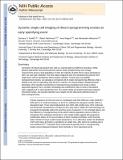| dc.contributor.author | Smith, Zachary D. | |
| dc.contributor.author | Nachman, Iftach | |
| dc.contributor.author | Regev, Aviv | |
| dc.contributor.author | Meissner, Alexander | |
| dc.date.accessioned | 2012-10-31T13:35:12Z | |
| dc.date.available | 2012-10-31T13:35:12Z | |
| dc.date.issued | 2010-05 | |
| dc.date.submitted | 2010-03 | |
| dc.identifier.issn | 1087-0156 | |
| dc.identifier.issn | 1546-1696 | |
| dc.identifier.uri | http://hdl.handle.net/1721.1/74519 | |
| dc.description | available in PMC 2010 November 1. | en_US |
| dc.description.abstract | The study of induced pluripotency often relies on experimental approaches that average measurements across a large population of cells, the majority of which do not become pluripotent. Here we used high-resolution, time-lapse imaging to trace the reprogramming process over 2 weeks from single mouse embryonic fibroblasts (MEFs) to pluripotency factor–positive colonies. This enabled us to calculate a normalized cell-of-origin reprogramming efficiency that takes into account only the initial MEFs that respond to form reprogrammed colonies rather than the larger number of final colonies. Furthermore, this retrospective analysis revealed that successfully reprogramming cells undergo a rapid shift in their proliferative rate that coincides with a reduction in cellular area. This event occurs as early as the first cell division and with similar kinetics in all cells that form induced pluripotent stem (iPS) cell colonies. These data contribute to the theoretical modeling of reprogramming and suggest that certain parts of the reprogramming process follow defined rather than stochastic steps. | en_US |
| dc.description.sponsorship | Burroughs Wellcome Fund (Career Award at the Scientific Interface) | en_US |
| dc.description.sponsorship | Pew Charitable Trusts | en_US |
| dc.description.sponsorship | Massachusetts Life Sciences Center (New Investigator grant) | en_US |
| dc.description.sponsorship | Broad Institute (Investigator of the Merkin Foundation for Stem Cell Research) | en_US |
| dc.description.sponsorship | Howard Hughes Medical Institute (Early Career Scientist) | en_US |
| dc.description.sponsorship | Alfred P. Sloan Foundation | en_US |
| dc.description.sponsorship | National Institutes of Health (U.S.) (Pioneer Award) | en_US |
| dc.language.iso | en_US | |
| dc.publisher | Nature Publishing Group | en_US |
| dc.relation.isversionof | http://dx.doi.org/10.1038/nbt.1632 | en_US |
| dc.rights | Creative Commons Attribution-Noncommercial-Share Alike 3.0 | en_US |
| dc.rights.uri | http://creativecommons.org/licenses/by-nc-sa/3.0/ | en_US |
| dc.source | PMC | en_US |
| dc.title | Dynamic single cell imaging of direct reprogramming reveals an early specifying event | en_US |
| dc.type | Article | en_US |
| dc.identifier.citation | Smith, Zachary D et al. “Dynamic Single-cell Imaging of Direct Reprogramming Reveals an Early Specifying Event.” Nature Biotechnology 28.5 (2010): 521–526. Web. | en_US |
| dc.contributor.department | Massachusetts Institute of Technology. Department of Biology | en_US |
| dc.contributor.mitauthor | Regev, Aviv | |
| dc.relation.journal | Nature Biotechnology | en_US |
| dc.eprint.version | Author's final manuscript | en_US |
| dc.type.uri | http://purl.org/eprint/type/JournalArticle | en_US |
| eprint.status | http://purl.org/eprint/status/PeerReviewed | en_US |
| dspace.orderedauthors | Smith, Zachary D; Nachman, Iftach; Regev, Aviv; Meissner, Alexander | en |
| dc.identifier.orcid | https://orcid.org/0000-0001-8567-2049 | |
| mit.license | OPEN_ACCESS_POLICY | en_US |
| mit.metadata.status | Complete | |
